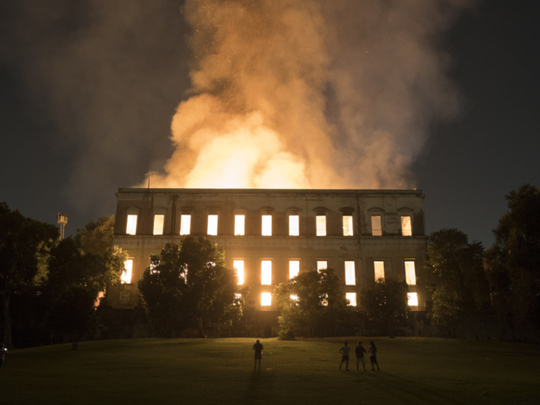
There have been no injuries reported after an enormous fire gutted Rio de Janeiro’s National Museum last week, but the toll was still immense. Officials suggested as much as 90 per cent of the museum’s collection — encompassing about 20 million objects — was destroyed by the blaze.
Some of the museum’s treasures may have survived, including the remains of Luzia, an 11,500-year-old fossil believed to be the oldest human skeleton unearthed in the Americas. But the fire probably consumed countless other pieces of Brazil’s patrimony: Dinosaur bones, ancient mummies, recordings of extinct indigenous languages, myriad artefacts that predated the arrival of Europeans and even temple frescoes removed from the Roman city of Pompeii and transported across the Atlantic. Their graceful images of peacocks and coiled dragons withstood the eruption of Mount Vesuvius two millennia ago, but they may now be lost.
Curators and academics are struggling to come to terms with the scale of the disaster. For some, it meant the disintegration of a career. “In terms of [my] lifelong research agenda, I’m pretty much lost,” said Marcus Guidoti, a Brazilian entomologist, to National Geographic. The museum’s collection of lace bugs — the world’s largest — and the rest of its 5 million arthropod specimens were all probably destroyed.
For others, it means an immeasurable blow to Brazil’s cultural memory. “We Brazilians only have 500 years of history,” anthropologist Mrcio Gomes wrote on Facebook. “Our National Museum was 200 years old, but that’s what we had, and what is lost forever.” According to my colleague Alex Horton, Gomes likened the event to the burning of the great library in Alexandria, Egypt, in 48 BC — a timeless metaphor for the catastrophic disappearance of human knowledge.
Numerous museum employees reportedly rushed inside the building while the fire raged, hoping to rescue what research they could from their work stations. “It is a pitiful tragedy. Inside it there are delicate and inflammable pieces, a fabulous library,” museum director Alexander Kellner told the Guardian. “The collection of the museum is not for the history of Rio de Janeiro or Brazil, it is fundamental to world history.”
The National Museum, the largest of its kind in Latin America, is an artefact of history itself. The 19th-century palace that was its main building was once home to the Portuguese royal family and a short-lived Brazilian imperial dynasty. It was the site of the signing of the country’s independence decree in 1822 and the birthplace of one of its emperors. And, as was the case with many of the great museums in the 19th century, it built its priceless collections through at times violent and brutal means.
This year, the museum was preparing to celebrate the 200th anniversary of its founding. Now university students in Rio are collecting photos taken by visitors to build a mournful virtual memorial to the objects once housed there.
It’s still unclear what caused the fire. Authorities speculated that a paper balloon carrying a small flame may have landed on the museum’s roof. According to the New York Times, investigators are also looking into whether a short circuit in one of the institution’s laboratories could have triggered the fire. Tragically, the preponderance of printed material, rare books and documents in the museum’s archives may have fed the blaze.
But while the flames have been subdued, they stoked Brazilians’ ire. Protesters clashed with police in Rio, linking the ruin of the National Museum to wider austerity measures and spending cuts that have left the country’s infrastructure in woeful disrepair. Reports point out that the building’s sprinkler system was not functioning properly; firefighters had to dredge water from a nearby pond because the hydrants by the museum did not work.
“The corruption that affects our health, our education, makes me sick,” Natan Campos, a street sweeper who works in the environs of the museum, told the Times. “But the feeling I have about the museum is sadness. We are forgetting our history. This amplifies our ignorance.”
Brazilian President Michel Temer — who has faced numerous allegations of graft since coming to power in 2016 — promised to raise private and public funds to help restore the museum and rebuild its collections. But museum officials point to a long legacy of budget cuts and neglect. The building itself was not insured. Earlier this year, the museum had to use a crowdfunding website to help raise $7,000 to deal with a termite infestation that had forced the closure of an exhibit.
“This is the genesis of your country ... do you understand?” Kellner, who is also a famous Brazilian paleontologist, said to reporters on Monday. “We need society to help us. A part of our heritage was taken from us. Don’t let us lose our history, because it’s the history of Brazil. Of all of you.”
In an age when major European museums can set up lavishly-funded satellites in other continents, the woes of the National Museum offer a reminder that many more countries are home to equally wondrous treasures, but lack the resources to safeguard them — and to help their populations appreciate their importance.
“Brazil is a fantastic country, a beautiful country, but it is blighted by the lack of education,” Brazilian author Paulo Coelho lamented in the Guardian. “Poor people in Brazil do not go to school, let alone to museums. Rich people go to museums — but in London, New York or Paris, not in Rio or Sao Paulo.”
Others are clinging to thin reeds of optimism. As workers searched the wreckage of the museums, they discovered that another iconic treasure, an ancient iron meteorite discovered by an 18th-century Brazilian cattle herder, had survived the flames.
“I’ve been inside, there are places where we can retrieve some things,” Kellner said. “We still do not know what, but I have hope.”
— Washington Post
Ishaan Tharoor writes about foreign affairs for the Washington Post.












